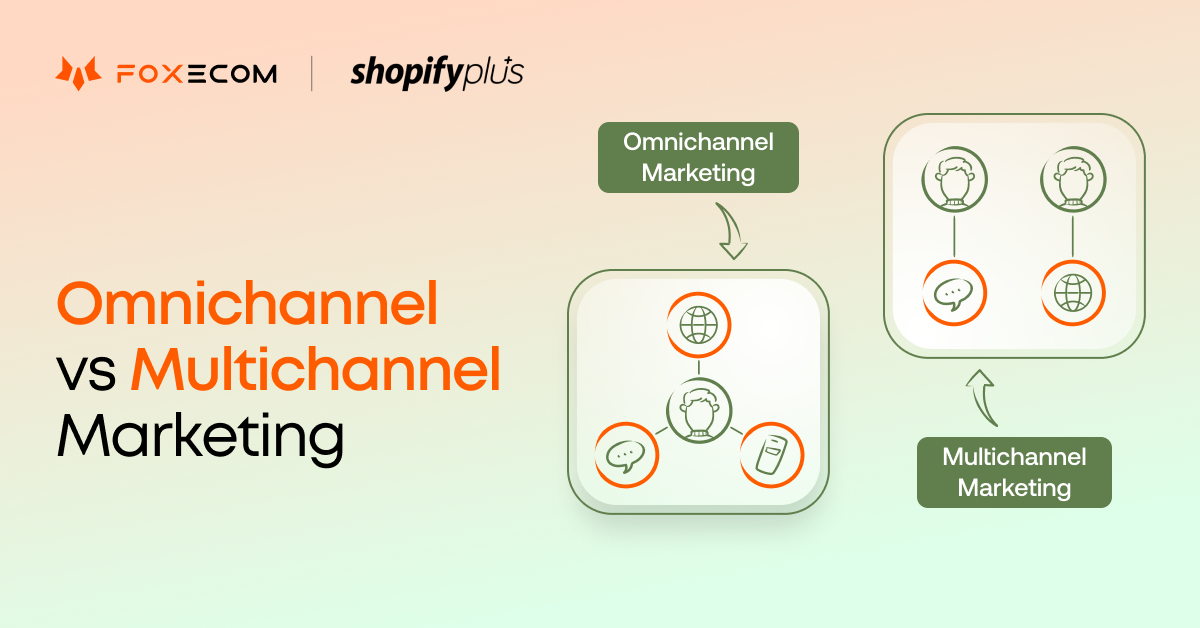Navigating the retail landscape requires a keen understanding of marketing strategies that connect with customers across multiple channels. This article explores the essential differences between omnichannel vs. multichannel marketing, helping businesses decide which strategy best supports their growth ambitions in 2024.
Whether you aim to enhance customer experiences or expand your market reach, the insights provided here will guide your strategic decisions, highlighting each approach’s advantages, challenges, and real-world applications.
What is Omnichannel marketing?
Omnichannel marketing is a strategy that integrates all marketing channels - online and offline - into a cohesive and seamless customer experience.
Unlike traditional marketing approaches, omnichannel marketing focuses on delivering a unified experience across every interaction, whether in-store, on social media, or through a mobile app.
The goal is to ensure customers can transition smoothly from one channel to another, with their preferences and data following them throughout the journey.

Source: SEMRush
Imagine browsing on your computer, receiving personalized notifications on your phone, and finally purchasing in the physical store where the staff already knows your preferences and purchase history.
Omnichannel marketing connects all these channels — online, mobile, and in-store — to work together smoothly, ensuring customers enjoy a unified and personalized shopping experience, no matter how or where they interact with the brand.
Pros of Omnichannel marketing
Understanding the definition is just the beginning. To fully grasp the value of omnichannel marketing, it’s crucial to weigh its pros and cons.
- Seamless Customer Experience: Omnichannel marketing creates a consistent brand experience across all channels, enhancing customer satisfaction. According to the Aberdeen Group, companies with robust omnichannel customer engagement strategies retain 89% of their customers, compared to just 33% for companies with weak strategies.

Source: clerk.io
- Increased Customer Loyalty and Engagement: Businesses can drive higher engagement rates by personalizing the customer journey based on integrated data. Research shows that businesses using omnichannel strategies achieve a 91% higher year-over-year customer retention rate than those without.
- Better Data and Insights: With unified data collection from all touchpoints, omnichannel strategies provide valuable insights into customer behavior, enabling businesses to make data-driven decisions.

Source: Bloomreach
Cons of Omnichannel marketing
- Complexity: Applying an omnichannel strategy requires heavy technological investment, such as CRM systems and data integration tools. This requirement can be a barrier for smaller businesses with limited resources.
- Higher Setup Costs: Integrating systems and software to ensure data consistency can lead to higher upfront costs. However, the long-term ROI often outweighs these initial investments.

Source: Sunzinet
Let's look at some omnichannel marketing examples to illustrate better how these advantages and disadvantages play out in the real world.
Omnichannel marketing model in practices
Let's look at some top-notch omnichannel examples to learn how these pros and cons play out in the real world.
Sephora
Sephora exemplifies a successful omnichannel retail strategy. The beauty retailer integrates its online and in-store experiences flawlessly. Customers can browse products online, check in-store availability, and even book in-store beauty consultations through the app.

Source: Sephora
Their Beauty Insider program syncs across all channels, ensuring personalized recommendations based on past purchases and browsing history.
👀 Learn more about the Sephora's Omnichannel Strategy.
Nike
Nike’s omnichannel retail strategy lets customers shop online, in-app, or in-store, seamlessly transitioning between channels. Their app provides personalized product recommendations, fitness tracking, pick-up options, and exclusive offers, creating an engaging and connected experience.

Source: Future Stores
👀 You may like to read How Nike Enhances Omnichannel Experience for Concept Stores in LA
What is Multichannel marketing?
Now that we’ve examined omnichannel marketing, it’s vital to understand multichannel marketing - another popular approach many businesses use to reach their audience.
Multichannel marketing involves using multiple channels to reach and engage customers. While businesses are present across several platforms - from websites, social media, to email, and brick-and-mortar stores - each operates independently. This approach allows companies to maximize their reach but lacks the integration expected in omnichannel strategies.
Like omnichannel marketing, multichannel marketing has its benefits and challenges. Let’s dive in!

Source: Active Campaign
Pros of Multichannel marketing
- Wider Audience Reach: Multichannel marketing ensures a presence wherever customers are, increasing visibility and reach. A study by Harvard Business Review found that 73% of consumers use multiple channels during their shopping journey, making multichannel strategies vital for broad engagement.
- Flexibility and Simplicity: Compared to omnichannel, multichannel marketing is more straightforward to implement as it doesn’t require complex integrations. It allows businesses to tailor content specifically for each channel, focusing on what works best for each platform.
Cons of Multichannel marketing
- Fragmented Customer Experience: Since each channel works by itself, multichannel customer experience is disjointed. Customers may receive inconsistent information or offers, leading to confusion and frustration.

Source: Faster Capital
- Lack of Integrated Data: Without unified data, providing personalized experiences is challenging, resulting in missed opportunities for engagement and loyalty.
- High Cost, Low Return: Managing multiple channels can be costly and yield low returns. Each channel requires time, money, and resources, increasing management complexity. Multichannel marketing tends to operate in silos, with departments and channels functioning individually, often lacking communication and crucial data-sharing. This fragmented approach can result in higher expenses, lower ROI, inconsistent messaging, and a confusing, repetitive customer experience.
Multichannel marketing examples
Finding examples of purely multichannel businesses can be tricky, as many brands are evolving toward omnichannel. However, some small to mid-sized retailers still operate with separate channels, embodying the multichannel approach. For example:
- Local Boutique Store: Imagine a local boutique that sells in-store and online but treats these channels as separate entities. Their website offers a different range of products than the physical store, and customers often need to call or visit the store to check stock availability. While they have a presence on social media, interactions are mainly for marketing purposes, without direct integration into their sales or customer service processes.
- Independent Online Sellers on Multiple Platforms: Many small businesses sell on platforms like Amazon or eBay, and their websites operate multichannel. Each platform serves as a separate sales channel, with no unified customer experience or integrated data sharing. This fragmentation often leads to inconsistent customer service, pricing, and product availability.
These examples highlight the essence of multichannel marketing - using multiple touchpoints to reach customers without the integration that defines omnichannel strategies. This approach works well for businesses seeking broad exposure but can need help providing a seamless customer experience.
What's the difference between Omnichannel and Multichannel?
Now it’s time to compare Multichannel and Omnichannel side-by-side to highlight their differences and which one might be the best fit for modern businesses.

Source: HubSpot
- Integration vs. Independence: Omnichannel marketing integrates all channels to create a cohesive experience, while Multichannel treats each channel independently.
- Customer-Centric vs. Channel-Centric: Omnichannel focuses on the customer journey and ensuring consistency, whereas multichannel optimizes each channel individually.
- Data Utilization: Omnichannel marketing leverages integrated data to personalize interactions, while multichannel often lacks the depth of insights due to fragmented data sources.
Given these differences, the question arises: which model should enterprises adopt in today’s competitive market? This question brings us to the next critical aspect - understanding customer insights that can guide this decision.
Which model suits your growing business - Omnichannel or Multichannel?
While multichannel marketing has been effective in expanding brand presence across various platforms, it falls short in delivering seamless and personalized experiences.
Omnichannel marketing, on the other hand, addresses these gaps by creating a unified customer journey that integrates all touchpoints - both online and offline.
As consumer expectations continue to evolve, the ability to provide a consistent, engaging experience across all channels is no longer optional; it's essential.
Customer insights for enterprises
Let's dig deeper into key customer insights that reveal why omnichannel marketing is increasingly the preferred choice for scaling enterprises. From the demand for personalized interactions to the value of unified data, these insights highlight why businesses should lean towards omnichannel over multichannel for long-term growth and success.
Demand for consistency in customer shopping experiences
According to a Salesforce report, 76% of consumers expect consistent interactions across departments, yet only 54% say that companies deliver on this expectation.

Source: Salesforce
Consistency in shopping experiences is crucial for building trust and retaining customers. Multichannel setups often result in disjointed experiences due to siloed operations. Omnichannel marketing integrates all touchpoints, ensuring customers receive a uniform experience, whether online, mobile, or in-store. This alignment meets and even exceeds customer expectations, directly impacting satisfaction and repeat purchases.
Personalized customer experiences drive loyalty
A study by Epsilon found that 80% of consumers are more likely to purchase when brands offer personalized experiences.
Personalization is a crucial driver of customer loyalty, and omnichannel marketing excels in this area by leveraging unified data to deliver personalized interactions across all channels.

Source: Bloomreach
For example, omnichannel systems can use past purchase history, browsing behavior, and preferences to tailor recommendations and communications, enhancing customer satisfaction and increasing the likelihood of repeat business.
Moreover, Omnisend has cited that businesses that adopt omnichannel strategies see 23x higher rates of customer satisfaction and 30% greater lifetime value than those that do not.
Omnichannel marketing enhances engagement by offering a seamless, personalized experience across all touchpoints, which we can call the Omnichannel customer experience.
This approach goes beyond simply having a presence on multiple channels; it creates a unified journey that fosters more profound connections with customers. Engaging with your audience consistently builds loyalty, which directly translates into higher lifetime value and increased customer retention. In today’s competitive landscape, this level of engagement is crucial for sustained growth.
📚 You might also like: 3 Expert Ideas to Leverage Website Personalization for Shopify Stores
Increasing mobile and cross-device usage
As mentioned above, 73% of consumers use multiple channels during their shopping journey, with mobile being a kevitalart of this mix (Harvard Business Review).

Source: Harvard Business Review
Moreover, 60% of global internet traffic comes from mobile users, and more than 56% of all eCommerce transactions are completed on mobile devices.
With the rise of mobile shopping, consumers frequently switch between devices when interacting with brands. Multichannel models often fail to provide a seamless cross-device experience, leading to cart abandonment and missed opportunities.
Omnichannel marketing, on the other hand, connects these touchpoints, allowing customers to easily transition between devices without losing their progress, driving higher conversion rates.
Thus, to drive as many sales as possible, your store must be mobile-optimized! How do you make your store mobile-friendly and capture these high-intent shoppers?
🔥 Explore our detailed guide on How to Boost Mobile Optimization for Your Shopify Store
These strategies enhance the user experience and strengthen your entire omnichannel approach, turning mobile touchpoints into valuable conversion opportunities.
Choosing the right theme is crucial for creating a website that delivers a seamless experience across all devices, especially mobile.
🚀 Suggested blogs for Omnichannel-model stores:
- 6+ Must-Have Features of A Shopify Theme for Mega Stores
- Megamog: Review the Best Converting Shopify Theme for Large Inventory Stores
- Sleek Theme: The Best Shopify Theme For An Interactive Website
Amongst well-regarded names in the market, we recommend you try the Zest theme. Zest is an ideal Shopify theme designed for businesses aiming to thrive in today’s mobile-first eCommerce landscape.
Benefits of Zest Theme:
- Ensure a smooth shopping experience with a mobile-optimized for speed and stability
- Designed with UX mobile-focused in mind, offering features that improve navigation and conversion rates.
- Choose from three beautiful demo styles tailored to various business needs.
- Enhance your store's visual appeal with a vast selection of free, high-quality images.
- Keep your store up-to-date with the latest features and improvements at no extra cost.
- Enjoy unlimited access with a single-store license, allowing you to focus on growth.
Optimize your eCommerce store for success with Zest, the theme built to meet the demands of a mobile-first world.
📚 You might also like:
- 5 Expert Tips to Optimize One-Page Checkout for All Shopify Stores
- Shopify Page Speed Optimization Hacks: The Lies They Tell You
- A 5-Step Guide to Shopify Optimization to Unleash Your Store's Power
Higher expectations for customer service
Salesforce said that 83% of customers expect to resolve complex problems by interacting with a single person, without being transferred.
These metrics cited that customer service expectations are higher than ever. They demand quick responses and consistent support across all channels.

Source: Knowmax
In a multichannel setup, customer data is often scattered, leading to delays and fragmented support. Omnichannel marketing overcomes this by integrating all service touchpoints into a unified platform, providing agents with complete visibility of the customer journey.
This real-time access to information enables faster, more personalized responses, directly addressing the need for speed and cohesion in customer interactions. The result is a more satisfying service experience that not only meets but often exceeds modern consumer expectations, setting brands apart from their competitors.
Value in unified data and analytics
Companies using omnichannel strategies retain an average of 89% of their customers, compared to 33% for companies with weak omnichannel strategies (Invesp).
One of the greatest strengths of omnichannel marketing is Unified data. It allows businesses to analyze customer behavior, supporting precise targeting, personalized marketing, and better decision-making. By pulling insights from every touchpoint, businesses can scale more efficiently, improve operations, and achieve higher ROI.

Source: Wipro
🎁 Expert Tips & Gifts:
- Retain your eCommerce customers using Omnisend Email and SMS strategies - 10% OFF
- Elevate your Omnichannel strategies with DingDoong personalized shipping - 20% OFF FOREVER
Why should you choose the Omnichannel marketing model?
Omnichannel marketing isn't just a trend - it's a strategic necessity for modern enterprises. The insights we discussed have underscored the core advantage of omnichannel marketing: its ability to create a seamless, integrated customer experience.

Source: Netmaxims
- Enhanced Customer Engagement: Omnichannel customer experience can lead to higher customer satisfaction and increased loyalty. This unified approach keeps customers engaged, and boosts repeat business.
- Increased Customer Lifetime Value: These strategies strengthen customer relationships, resulting in higher retention rates and greater lifetime value. Customers are more likely to return and spend more when they experience a cohesive brand journey.
- Improved Operational Efficiency: Integrating multiple channels into a unified system streamlines processes between marketing, sales, and customer support departments and reduces operational redundancies. This leads to significant cost savings, allowing businesses to optimize their resources.
- Superior Data-Driven Insights: Omnichannel marketing provides a comprehensive view of customer behavior, enabling better decision-making. With a unified data approach, businesses can optimize their strategies and improve targeting, driving more effective marketing outcomes.
Choosing omnichannel marketing offers significant benefits, including improved customer engagement and operational efficiency. However, enterprises should be prepared and don't expect immediate results; omnichannel success requires investment in technology and time to integrate systems fully.
Support platform for Omnichannel marketing model businesses
To fully leverage the benefits of omnichannel marketing, choosing the right platform is crucial. Shopify Plus stands out as a powerful solution designed to support complex omnichannel strategies and help businesses scale effectively. Here’s how Shopify Plus supports omnichannel marketing:
Shopify Plus for Omnichannel business model
Shopify Plus is an advanced, enterprise-level eCommerce platform that offers robust features tailored to high-growth businesses. It provides the flexibility, scalability, and integration capabilities required to execute a successful omnichannel marketing strategy. With Shopify Plus, businesses can manage and unify their sales channels, enhance customer experiences, and optimize operations seamlessly.

Source: Shopify Plus
How Shopify Plus supports Omnichannel businesses
In today’s competitive market, omnichannel commerce is no longer optional; it’s essential. Shopify Plus offers a comprehensive solution for businesses aiming to create a seamless omnichannel customer experience. Here's how it supports enterprises navigating the omnichannel vs multichannel retail landscape:
Unified sales integration
Shopify Plus connects all your sales channels - online, in-store, social media, and marketplaces - into one cohesive system. This integration ensures a smooth transition for customers between different platforms, a vital feature distinguishing omnichannel from traditional multichannel marketing.
Centralized inventory and order management
With Shopify Plus, businesses gain a centralized view of inventory and orders, preventing stock discrepancies and ensuring consistency across all touchpoints. This streamlined approach significantly reduces operational friction, enhancing overall efficiency.
Data-driven personalization
A significant advantage in the multichannel marketing vs omnichannel marketing debate is Shopify Plus’s ability to aggregate customer data from various touchpoints. This data powers personalized marketing, refined customer interactions, and insights that drive strategic decisions.
Customization and scalability
Shopify Plus offers scalable solutions tailored to growing business needs. Its robust APIs and integration options allow businesses to customize their platform, supporting sophisticated omnichannel strategies as they expand.
Streamlined marketing and automation
Integrated marketing tools on Shopify Plus ensure your promotions are consistent across all channels. Automation features free up time for your team, enabling a more strategic approach to omnichannel customer engagement.
Shopify Plus empowers businesses to deliver a unified shopping journey, making it the preferred choice for companies seeking effective omnichannel customer experience solutions. Its seamless integration, advanced data capabilities, and flexibility set it apart in the omnichannel vs multichannel retail comparison, positioning businesses for sustainable growth in a digital-first world.
🔥 Learn more about Shopify Plus and its omnichannel marketing solutions at:
Final thoughts
As businesses look to scale in 2024, the choice between omnichannel and multichannel marketing can significantly impact their success.
While multichannel marketing offers broad reach, omnichannel marketing’s ability to create a cohesive and personalized customer experience positions it as the superior choice for enterprises seeking to thrive in a competitive market. By leveraging platforms like Shopify Plus, businesses can effectively implement omnichannel strategies, driving customer loyalty, engagement, and long-term profitability.
For enterprises ready to elevate their marketing game, the omnichannel approach isn’t just an option—it’s the key to staying ahead.






